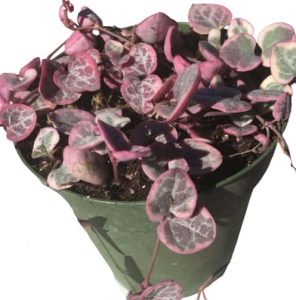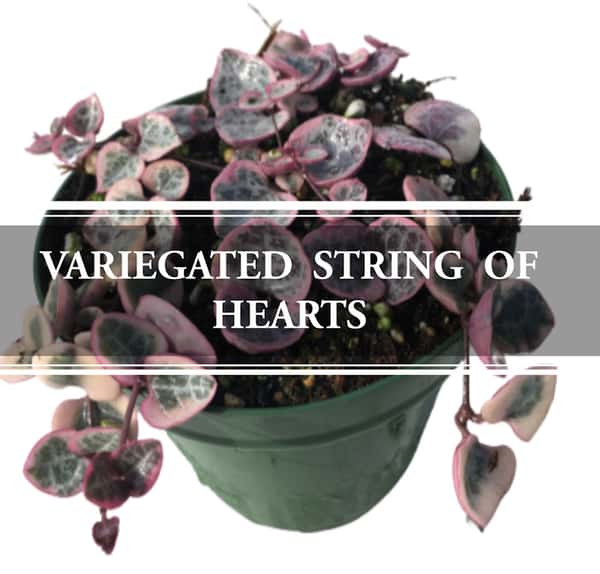Are you looking for a low-maintenance vine with pinkish variegation? We are going to discuss the Variegated String of Hearts vine, botanically known as the Ceropegia woodii variegated. The heart-shaped succulent leaves are green and white with pinkish hues near the edges. The pinkish shade darkens at the back of the leaves adding to the beauty of the plant.
This creeper can grow up to 4 meters long and are perfect to make indoor hanging baskets. Thinking to grow these sweethearts? Good news peeps! This resilient plant is good enough for beginners and lazy peeps. So, don’t think twice before getting these dandy danglers. Let us know more about the beautiful String of Hearts Variegated plant along with its care and propagation.
Variegated String of Hearts Classification
Family: Apocynaceae.
Genus: Ceropegia.
Species: C. woodii.
Binomial name: Ceropegia woodii variegata
Let us get an outline about the genus to help you know the plant better.
Genus Ceropegia
Ceropegias are native to Australia, Africa, and South Asia. Carl Linnaeus first introduced this genus in 1753. The main feature of these plants is the tubular corolla with 5 or more petals. These petals uniquely join at the tips forming a tube or an umbrella-like canopy. This tube-like structure of the flowers refers to the name of the genus which means the ‘wax fountain’.
The growth habit of Ceropegia mainly includes creepers. Moreover, they include a few erect growers like the woodii plant. These plants are associated with a number of common names. These include Wine-glass vine, necklace vine, rosary vine, parachute flower, lantern flower, and many others.
These plants are extensively used in ornamentation. Moreover, Africans like to eat the raw roots of these plants.
Variegated String of Hearts Other Names
The Ceropegia woodii and its variegated type are found under a variety of common names. These names include the variegated chain of hearts, the collar of hearts, rosary vine, hearts-on-a-string, and the sweetheart vine.
The pinkish hues in the variegated C.woodii make it popularly known as the Pink Variegated String of Hearts.
Features of the Variegated String of Hearts Plant

The Woodii variegate is quite similar to the original Ceropegia woodii plant. The main difference is the absence of pinkish hues which are replaced with white borders in the original plant. All other features and care of the variegated cultivars are pretty similar to that of the parent plant.
Height and Structure
The vine usually remains below 10 cm in height. However, the length usually gets around 4 meters.
Leaves
- Each heart-shaped mature leaf usually gets about 4 cm in size.
- The succulent leaves grow in an alternate pattern on purplish dangling stems.
Flowers
- The vine blooms with beautiful purplish-pink tubular flowers bloom in summer.
Toxicity
The Ceropegia Woodii Variegata and the related plants are usually non-toxic for humans and pets. However, it is always better not to let kids and pets mingle with the plants.
Variegated String of Hearts Care
The low-maintenance nature of this beautiful succulent vine makes it win the hearts even more. Let us have a look at the basic care and requirements;
Water Requirement
Good news folks! The sweetheart vine is actually a sweetheart. It can tolerate a little neglect in watering. Just water thoroughly and let the soil get dry between waterings. Check the soil and water when it gets about 90% dry.
The watering frequency depends upon the weather and the growth zone. Generally, once or twice a week is enough for the summer. However, the dormant winter plant needs a little water. Once in every 12 to 15 days will be enough to keep the plant happy.
These plants hate standing in water. Thus, avoid over-watering or keeping the soil soggy.
Sunlight Requirement
The vine loves to be in bright indirect sunlight. The variegated variety is more in love with bright light as compared to the simpler one. Any well-lit spot or window is ideal to keep the plant. Make sure the sun rays do not reach the delicate foliage directly.
Temperature Requirement
The ideal temperature range for the plant is between 65 to 90 °F. At night, it is better to keep the temperature above 40°F. These plants have poor tolerance for cold and frost. Thus, make sure you transfer them to a warmer stop as soon as the temperature is expected to fall below 40 °F.
Humidity Requirement
No extra demands of humidity from the Woodii vines. The average humidity of your area is enough to keep the plant happy.
Soil Requirement
Any well-draining houseplant mixture like a cactus or a succulent mixture is good to go.
Fertilizer Requirement
These delicate vines are don’t like heavy feeding. Use any ordinary house plant fertilizer in the diluted form once a month from March to August. The colder days make the plant go dormant. So, you don’t need to provide any fertilizer in winter.
Cutting and Pruning Requirements
You can remove the older leaves to maintain the health and appearance of the plant. Trimming will help you to get rid of dead, straggly, and over-grown foliage.
Growth Zone
This plant is hardy in USDA Zone 10 and 11a (Minimum 40 F or 4.5 C). So, you can keep growing them outdoors in this zone.
Variegated String of Hearts Propagation
The String of Hearts Variegated is pretty easy to propagate. You can make as many new plants and gift them to your beloveds. This justifies the comparatively higher price of these succulent hearts.
Season
The growing season of spring and summer shows ideal results for the propagation of this plant.
Method
We are going to explain the propagation in steps to help you understand better;
Rooting the Plant Cuttings
- Just take 5 to 7 inches of plant cuttings from the growing end. Remove a few leaves from the top and make sure the stem cuttings have nodes on them.
- Now take a jar and fill it with tap water. Dip the cuttings in the water keeping the lower side and at least a node in the water.
- Keep the jar in a warm place with indirect sunlight. A warm window sill with plenty of indirect light is a good spot to place the jar.
- Keep changing the water twice a week or before the water gets murky.
- Tiny rootlets will develop after about 2 weeks. Wait for two more weeks to let the roots grow to at least half of a centimetre.
Potting the rooted cuttings: - Now, it’s time to plant the rooted cuttings in soil or growing the mixture.
- Fill a pot with a suitable growing mixture. Take the cuttings out of the water and dry the roots with tissue paper to remove the excess water.
- Now plant the cuttings in the soil. Keep the set up in the same well-lit place with indirect light.
- Spray the soil mildly about twice a week to keep the soil moisturized.
- Two more weeks to go and you will see the shoot development.
Boom! Keep watering and enjoying the growth of the sweet-heart vine. You will soon see well-grown vines to decorate your surroundings or to gift it to your beloveds.
Summary
Variegated String of Hearts is a perennial succulent vine. Numerous heart-shaped leaves grow alternately on long dandy stems of the creeper. The green and white leaves appear with purplish to pink variegation near the edges. This pinkish hue goes deeper up to the back of leaves. Moreover, it is responsible for creating the minor difference between the original and the variegated plant.
The Variegated String of Hearts Care includes bright indirect light and thorough watering after the soil is about to dry out completely. These delicate peeps are excellent for making indoor hanging baskets and table pots.

